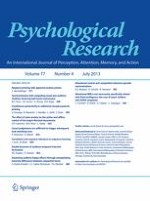01-07-2013 | Original Article
Conditional automaticity in subliminal morphosyntactic priming
Gepubliceerd in: Psychological Research | Uitgave 4/2013
Log in om toegang te krijgenAbstract
We used a gender-classification task to test the principles of subliminal morphosyntactic priming. In Experiment 1, masked, subliminal feminine or masculine articles were used as primes. They preceded a visible target noun. Subliminal articles either had a morphosyntactically congruent or incongruent gender with the targets. In a gender-classification task of the target nouns, subliminal articles primed the responses: responses were faster in congruent than incongruent conditions (Experiment 1). In Experiment 2, we tested whether this congruence effect depended on gender relevance. In line with a relevance-dependence, the congruence effect only occurred in a gender-classification task but was absent in another categorical discrimination of the target nouns (Experiment 2). The congruence effect also depended on correct word order. It was diminished when nouns preceded articles (Experiment 3). Finally, the congruence effect was replicated with a larger set of targets but only for masculine targets (Experiment 4). Results are discussed in light of theories of subliminal priming in general and of subliminal syntactic priming in particular.
